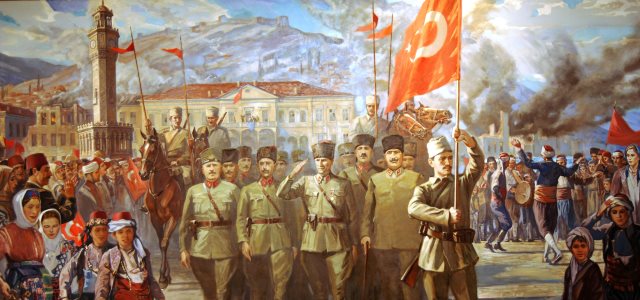1. The Battle of Kadesh 1274. B.C.
The Battle of Kadesh was between Egypt and the Hittite Empire, which flourished on the territory of present-day Turkey. These were the two largest countries of the time that clashed for influence over Syria and trade routes. On one side was the army of Ramesses the second, and the other was Muwatalli II, and the battle involved over 60,000 men and about 6,000 chariots. According to the number of chariots, this battle can be compared to the tank battle at Kursk, which involved a similar number of tanks. Both sides claimed to have won, but it is usually considered that the real winner was Egypt. The battle resulted in the first peace treaty in recorded history.
2. The Battle at Marathon 490. B.C.
This was the most important battle between Persia and Greece, and it ended Persian territorial expansion toward the West. The Greeks had negligible losses, and the battle showed the superiority of well-trained Greek armored infantry. The fight against Persia united Greek cities and contributed to the development of Athens as a leading city of the Greek world.
3. The Battle of Gaugamela 331. B.C.
The Battle of Gaugamela was the greatest victory of Alexander the Great against the Persian Empire and Darius III. Alexander was outnumbered but won thanks to the successful tactics. After the battle, Emperor Darius was murdered, and Alexander took over entire Persia. The conquest of Persia resulted in the emergence of Hellenism as the largest cultural movement of the old era.
4. The Battle of Zama 202. B.C.
Battle of Zama was the only defeat that suffered Hannibal, the great Carthaginian military commander, but the defeat had enormous consequences. After the defeat of Carthage, Rome became the greatest military power in the West of the Mediterranean Sea and soon started with the conquest of one country after another.
5. The Fall of Constantinople 1453. A.D.
Until 1453, the Ottoman Empire has reduced the territory of the former Eastern Roman Empire (A.K.A. Byzantium) to Constantinople with its surroundings. Constantinople had great walls but also a serious lack of people for defense. The siege of Constantinople lasted from 6 April to 29 May 1453. The defense was led by the last Byzantine emperor Constantine XI Palaiologos, while the Ottoman army was led by the twenty-one-year-old Sultan Mehmed II (Mehmed the Conqueror). After the fall of Constantinople, the Roman Empire, which lasted over 1500 years, has ceased to exist.
6. The Battle of Tours A.K.A. The Battle of Poitiers 732. A.D.
This battle has prevented further expansion of the Umayyad Caliphate in Europe. Caliphate held the whole Iberian Peninsula and continued expansion towards Gaul. The opponent of Caliphate was Charles Martel, leader of the Franks and founder of the Carolingian dynasty. He managed to win the Caliphate army withdrew to the Iberian Peninsula. After this victory, Franks began to gain in importance under the Carolingian dynasty, and his grandson was Charlemagne, the first ruler of the Holy Roman Empire, which was later established.
7. Siege of Vienna 1683.
This was the battle between combined Christian forces against the Ottoman Empire. The leader of the Christian forces was Jan Sobieski, Polish king, while the military campaign of the Ottoman Empire led by Grand Vizier Kara Mustafa Pasha. Unsuccessful siege of Vienna is considered as the beginning of the end of the Turkish domination in Europe.
8. The Battle of Waterloo 1815. A.D.
This was the last Napoleon’s battle in which he was defeated. The battle took place in present-day Belgium. After Napoleon came back to power, two armies were sent against him. The coalition of European countries was against the re-arrival to the power of Napoleon, especially after prolonged fighting they had with him in previous years. After the defeat, Napoleon was sent to St. Helena Island, where he died in 1821. Napoleon’s defeat brought a few decades of relative peace in Europe.
9. The Battle of Cajamarca 1532. A.D.
Battle of Cajamarca is the official name for the ambush made by Spanish conquistadors led by Francisco Pizarro. On that occasion, the last ruler of the Inka was killed. The Incas did not have a chance because they did not use firearms, so the conquistadors destroyed the Inca civilization very easily.
10. The battle of Yorktown 1791. A.D.
The most important battle of the American Revolutionary War between American and French troops on one side and British soldiers on the other. George Washington led American troops. Commander of the British forces was British lord and Lieutenant General Charles Cornwallis. After Cornwallis surrendered and his army was captured, negotiations have begun which led to the Independence of the United States of America.
11. The Battle of Cambrai 1917. A.D.
This WWI battle between the German and British army was important because of the first mass use of tanks as a weapon. The British military used 476 tanks and managed to push back the German army six kilometers in a few hours and to capture 8,000. German soldiers. The next day Germans managed to bring back the lost territory, but it became clear that tanks will shape future warfare.
12. The Battle of Stalingrad 23 August 1942 – 2 February 1943
This was the major battle between the Soviet Union and Nazi Germany on the Eastern Front during WWII. The battle involved over 2,2 million soldiers, and it was one of the bloodiest battles in human history. Nazi Germany had suffered heavy losses at Stalingrad, and the victory of the Soviet Army has stopped the further advance of the Germans towards the east.
13. The Battle of Kursk 1943.
This battle arose as a result of the operation Citadel launched by the German army. The Soviets at Kursk suffered heavy losses, but the German offensive was stopped. From this battle, the initiative was on the side of the Soviets, and they headed slowly towards Berlin.
14. D-day 6 June 1944.
D-Day was the beginning of the Allies landing in Normandy and the beginning of the end of German military power in the West. The landing was a part of the Allied operation with the code name Operation Overlord. The Allies managed to deceive Germans and successfully landed, although on the first day lost more than 10,000 soldiers. From that day, the Allies advance towards Berlin from the West.
15. The Turkish War of Independence (May 19, 1919 – July 24, 1923)
In the early 20th century, the Ottoman Empire experienced a serious crisis with losing a large part of its territory. During World War I, the Ottoman Empire supported Germany, and after the defeat in the war was occupied. Occupation of the Allies sparked the resistance of the Turkish nationalists led by Mustafa Kemal. Mustafa Kemal managed to get Turkish independence and transformed Turkey into a modern secular state. His compatriots gave him the name “Ataturk” – Father of the Turks.



















One Response
It is interesting that from The Battle of Marathon to the Siege of Vienna, for 2373 years the battles were between the Greco-Roman West and the “East” as the East repeatedly tried to overwhelm a culture that sought individualism and thinking rather than truth declared by God and a culture of tribe, not individual. Now, we have a resurgence of this ancient war, but in the new war the west refuses to even engage but rather to welcome a conquering hoard in the name of diversity and equity. Even during the Roman Empire the “East” was often (?usually?) rejecting the west and was subjected and ruled by ruthless force. The two will never exist together. Unfortunately the “West” welcomes it’s future rulers who will subject it’s culture with a force even more ruthless as in the past.